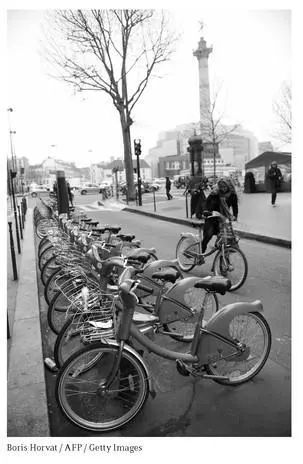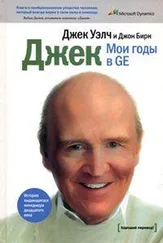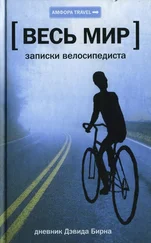He goes on to say, “Since we took these steps [in Bogotá], we’ve seen a reduction in crime and a change in attitude toward the city.” I can see why. When there are constantly people on the streets the streets are automatically safer. The late Jane Jacobs made a big point of this in her famous book, The Life and Death of Great American Cities. In healthy neighborhoods people watch out for one another. Being in a car may feel safer, but when everyone drives it actually makes a city less safe.
For New York, Peñalosa recommended first imagining what a city could be, what would one wish for, what could be achieved, in a hundred or more years. As with the great Gothic cathedrals one has to imagine something that one will not see in one’s lifetime, but something one’s children or grandchildren may experience. This also frees one from quickly dismissing an idea as too idealistic or as pragmatically improbable. Of course, like dealing with global warming, long-range planning needs political will, which is something that ebbs and flows, rises and falls. We can be guardedly optimistic, because if there is precious little of that will at times, it doesn’t mean that there will never be any.
He asked that we imagine Broadway, the longest street in the United States, as a pedestrian street. He asked that we imagine reclaiming contact with the East River and dismantling the FDR Drive. And, as an interim measure, he suggests we might begin slowly, by turning one long street, like Broadway or Fifth Avenue, into a pedestrian street just on Sunday afternoons. (The fact that New York City businesses don’t rely much on car access and don’t have massive parking lots out front like shops in the suburbs makes this all within the realm of possibility.) Well, Sadik-Khan took his advice on that last bit, and the Park Avenue closings in the summer of 2008 were a step in this direction.
In my opinion, Forty-second Street could easily be a pedestrian street—well, it almost is now, with all the stalled traffic, picture taking, and jaywalking. Imagine it as an elongated plaza, with theaters, restaurants, trees, and, in the middle of the street, seating and outdoor cafés . . . and free WiFi.
Since the onslaught of the automobile in the middle of the last century, and the efforts of its enablers, like Robert Moses in New York, the accepted response to congestion has been to build more roads, especially roads that are high speed and with limited access. Eventually it became clear that building more roads doesn’t actually relieve congestion—ever. More cars simply appear to fill these new roads and more folks imagine that their errands and commutes might be accomplished more easily on these new expressways. Yeah, right. People end up driving more, so instead of the existing traffic levels remaining constant and becoming dispersed on the new ribbons of concrete, the traffic simply increases until those too are filled. That’s what New York and a lot of other cities are realizing now. The old paradigm is finally being abandoned.
In Lyon, a bike loan system was initiated some years ago that has now been introduced in Paris. In this system, called Vélib’ (velo=bike, lib=free/freedom) a subscriber swipes a credit card at one of many stations to obtain a bike. The bike is then released, and the first half hour is free. The credit card swipe is mainly for security: if you steal it, you bought it.
There are stations all over Paris—most are not more than three hundred meters from each other—so your bike can be deposited at or very near your destination. If you go for a longer ride, longer than thirty minutes, then you are charged, and the cost ramps up steeply, discouraging long excursions. So, if you just go on short trips—to meet a friend for dinner or lunch or go to the movies or to get some bread or milk—it’s virtually free, as the subscription fee is minimal.

The Vélib’ system was partly funded by a deal made with an outdoor display company—JCDecaux. The company paid for the right to sell display space on city structures, like public rest-rooms (which the company builds), bus stops, and newsstands, and in return they funded the Vélib’ system. This deal actually generates money for the city, as well as having revolutionized the way Parisians get around.
Not only how they get around, but what other kinds of choices they make as city dwellers and how they feel about their city. In the past one’s activities might have been considered and limited by Métro schedules and routes, taxi availability, and other factors like parking and traffic. The bikes liberate one from all those concerns, as well as create a mood of conviviality and social comfort—as in Bogotá.
Rumor is this system will be tested on Governors Island just off the southern tip of Manhattan—to see if the credit card technology works, I guess. Then I hear it will be tried out in a limited area like the Lower East Side or the East Village, which would seem appropriate, as a lot of people go to events and work in that area and never leave it.
In a way, these folks who are working to reinvigorate their cities all owe a debt to Jane Jacobs, who in 1968 fought Robert Moses’s plan to run a highway through downtown New York City. It was previously thought that Moses was unstoppable. He managed to make it seem that he was the voice of inevitable progress and that wiping out neighborhoods to get closer to Le Corbusier’s or General Motors’ vision of the futuristic Radiant City was the voice of reason. Jacobs, besides elucidating what made some neighborhoods work and others not, made a case for cities being places where a good and stimulating life could be had.

This was news to many. In those days—the late 1960s and early ’70s—a lot of people in the United States seemed to believe that cities were soon to be things of the past, that modern life could only be properly lived in a suburban house with a yard, linked to the urban workplace—a clump of high-rise office buildings—by a network of highways. One place for working, another for living. L.A. and other similar cities were the wave of the future, and New York, to survive, would be forced to emulate their example. Or so it was thought.
As it turned out, most people are now leaning more toward Jacobs’s realization that the formula of separating living and working inevitably results in little actual life taking place in either area. The suburbs became weird quiet bedroom communities where kids are bored out of their skulls. Their parents only sleep or shop there, so for them it doesn’t matter—until junior gets into drugs or massacres his classmates.
Jacobs famously called what happened daily on her block in Greenwich Village a “sidewalk ballet.”
“I make my own first entrance into it a little after 8 when I put out the garbage can. . . . Soon after . . . well-dressed and even elegant men and women with briefcases emerge from doorways and side streets, and simultaneously, numbers of women in housedresses have emerged and as they crisscross with one another they pause for quick conversations that sound with either laughter or joint indignation, never, it seems, anything in between.”
She realized that mixed use was key. That when a street or park is used by different kinds of people at different times of the day it stays economically and socially healthy, and is safer. You don’t need more cops and harsh laws to make a neighborhood safe. You need to not suck the life out of it. Jacobs saw that what feeds into a park or a street affects the health of that street as much as what is actually on that street. Nothing in a city is isolated, and no part remains unaffected by the life (or the non-life) of the blocks surrounding it. All these organic structures and processes that she noticed and elucidated were, of course, not dictated from above. There was no urban planner who had designed these healthy lively neighborhoods as I somewhat implied in the Manila chapter. Instead of destroying them planners could and did learn from neighborhoods.
Читать дальше











